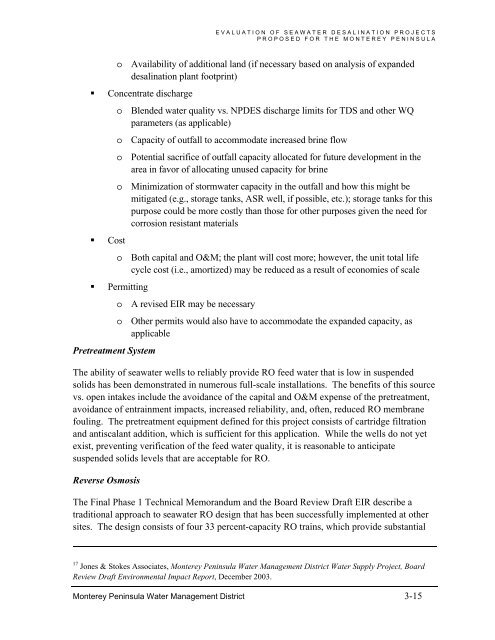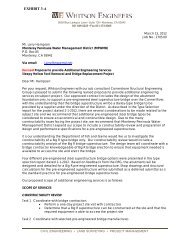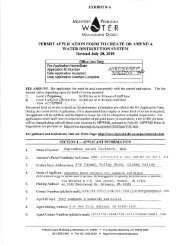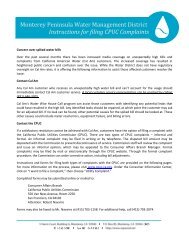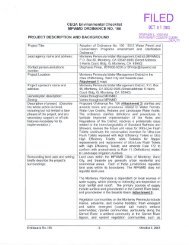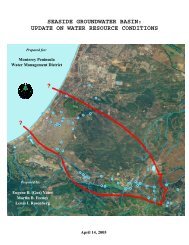FINAL REPORT Evaluation of Seawater Desalination Projects ...
FINAL REPORT Evaluation of Seawater Desalination Projects ...
FINAL REPORT Evaluation of Seawater Desalination Projects ...
Create successful ePaper yourself
Turn your PDF publications into a flip-book with our unique Google optimized e-Paper software.
EVALUATION OF SEAWATER DESALINATION PROJECTS<br />
PROPOSED FOR THE MONTEREY PENINSULA<br />
o Availability <strong>of</strong> additional land (if necessary based on analysis <strong>of</strong> expanded<br />
desalination plant footprint)<br />
• Concentrate discharge<br />
• Cost<br />
o Blended water quality vs. NPDES discharge limits for TDS and other WQ<br />
parameters (as applicable)<br />
o Capacity <strong>of</strong> outfall to accommodate increased brine flow<br />
o Potential sacrifice <strong>of</strong> outfall capacity allocated for future development in the<br />
area in favor <strong>of</strong> allocating unused capacity for brine<br />
o Minimization <strong>of</strong> stormwater capacity in the outfall and how this might be<br />
mitigated (e.g., storage tanks, ASR well, if possible, etc.); storage tanks for this<br />
purpose could be more costly than those for other purposes given the need for<br />
corrosion resistant materials<br />
o Both capital and O&M; the plant will cost more; however, the unit total life<br />
cycle cost (i.e., amortized) may be reduced as a result <strong>of</strong> economies <strong>of</strong> scale<br />
• Permitting<br />
Pretreatment System<br />
o A revised EIR may be necessary<br />
o Other permits would also have to accommodate the expanded capacity, as<br />
applicable<br />
The ability <strong>of</strong> seawater wells to reliably provide RO feed water that is low in suspended<br />
solids has been demonstrated in numerous full-scale installations. The benefits <strong>of</strong> this source<br />
vs. open intakes include the avoidance <strong>of</strong> the capital and O&M expense <strong>of</strong> the pretreatment,<br />
avoidance <strong>of</strong> entrainment impacts, increased reliability, and, <strong>of</strong>ten, reduced RO membrane<br />
fouling. The pretreatment equipment defined for this project consists <strong>of</strong> cartridge filtration<br />
and antiscalant addition, which is sufficient for this application. While the wells do not yet<br />
exist, preventing verification <strong>of</strong> the feed water quality, it is reasonable to anticipate<br />
suspended solids levels that are acceptable for RO.<br />
Reverse Osmosis<br />
The Final Phase 1 Technical Memorandum and the Board Review Draft EIR describe a<br />
traditional approach to seawater RO design that has been successfully implemented at other<br />
sites. The design consists <strong>of</strong> four 33 percent-capacity RO trains, which provide substantial<br />
17 Jones & Stokes Associates, Monterey Peninsula Water Management District Water Supply Project, Board<br />
Review Draft Environmental Impact Report, December 2003.<br />
Monterey Peninsula Water Management District 3-15


